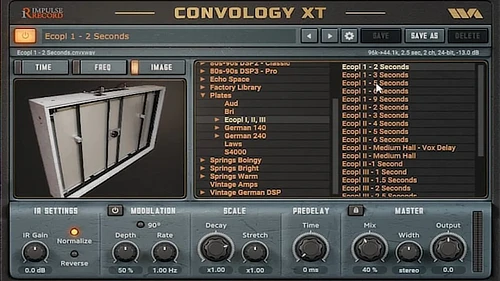TC Electronic Reverb 4000 is the first stereo Reverb capable of rendering credible space onto two discrete sources, or to truly process a composite stereo source. Quite simply, TC Electronic Reverb 4000 gives you the most immense and innovative selection of State-of-the-Art stereo Reverbs – at the touch of a button.
Designed as a single rack space module with an extremely easy-to-use, instant-access interface, and with the option of using the ICON software editor for PC and Mac in DAW environments, TC Electronic Reverb 4000 is the ultimate choice for live and studio applications working in stereo.
TC Electronic Reverb 4000 complements any large-scale mixing console and provides the professional studio with the ultimate Main Reverb featuring an amazing palette of simulated rooms from natural sounding credible spaces to emulations of vintage reverbs and TC Classics.
TC Electronic Reverb 4000 integrates perfectly with DAWs and features 24-bit AD/DA converters as well as 44.1 to 96kHz Sample Rates. Connect to the included ICON software editor via USB for easy access, complete overview and detailed editing.
The Instant Access front panel is a great advantage for Live applications. Never before has a Main Reverb provided so many colours to the palette and been so easy to operate. Switch between Character, Glossy and Vintage Reverb effects with just a single touch of a button.
The front panel always keeps important parameters within reach, and thanks to the latest DSP and power supply technology, as well as our heritage of making top-end reverbs, TC Electronic Reverb 4000 delivers the best true stereo reverbs imaginable.
TC Electronic Reverb 4000 comes fully loaded with seven pristine reverb algorithms, covering both generic and source reverb types. With these algorithms at hand, you can rest assured that you will be able to find – or tailor – the perfect reverb no matter what type of production you’re working on.
- NonLin2 – NonLin2 is an Effect Reverb with controllable Envelope, Attack, Hold and Release, encouraging you to experiment and be creative going from subtle or extreme.
- VSS4 – Stereo Reverb that radically departs from blurry sustain concepts of the past. Based on source related reflections from multiple angles, the precision of VSS4 is comparable to real-world mono or stereo sources positioned in an authentic space.
- VSS3 – A true-to-life sound to mimic environments. We’ve designed this algorithm to establish incredibly convincing room types with a “true-to-life” sound.
- VSS4 TS – For film work, multiple mono reverbs may often be more useful than pre-configured structures for stereo or 5.1. VSS4 TS gives you 2 completely independent mono reverbs.
- Ambiator – Small space modeler with integrated panning of a source. Try it when you grow tired of power panning or just need to add that subtle sense of ambience bringing life and character to certain elements of a mix.
- DVR2 – Generic Reverb with a true vintage flavour and a flattering sustain effect. It complements Source Reverb very well, and both can be great for different types of reverb applications.
- Reverb-4 – Generic Reverb. Suited for composite material and main microphone processing. It adds spaciousness rather than localisation to your audio image.
Our innovative and attractive TC Icon Remote is able to control a wide range of our units – including Reverb 4000.
- Incredibly Fast Response on Touch Screen and Faders
- Attractive and User-Friendly User Interface
- Controls Even More Studio and Broadcast Units from TC With Dual
- Ethernet and Dual USB ports
- Add a Loudness Meter to Your Audio Arsenal
- Integrate Multiple Mainframes and TC Icons/Editors into Your Network
Back in the day, reverb was mostly used as a Generic effect applied to many sources of a mix. Nowadays, where you have more aux send and returns and new approaches have emerged. Tracks are treated individually, adding room character, flavour and depth in creative and complex ways. We call this a Source-based approach, and we have put more than 30 man-years of development time into design and refinement of Source-based room simulation.
Even though we may now consider Generic types to be less than ideal, there are still applications for which they may be chosen instead of their Source-based cousins. Our large reverb and room simulation palette of High-end reverbs allows you to choose whatever principle that suits your present need.
Generic reverb is primarily a flattering sustain effect that you can add to many sources of a mix. It adds little character but also does no harm, as the effect is blurred or washed out. For a graphical artist, the equivalent tool to Generic reverb would be a paintbrush.
Generic Reverb Pros
- 1st choice for composite, mixed material and stems
- Ideal with multichannel joystick on console or DAW
- 1st choice for adding to classical main microphone pick-up
- Works well on moving sources
Generic Reverb Cons
- Blurring takes away character from individual sources
- Pitch modulation may be a problem with some material
- Mono compatibility often compromised to obtain width
- Imaging inferior to Source based reverb
When it is desirable to distinguish between single elements sharing approximately the same panning position, source-based reverb is your first choice. Subtle discrimination between reflection patterns of individual sources can make all the difference in the world when it comes to obtaining depth, expression and natural imaging. Source Reverbs are able to generate multiple, complex Early Reflection patterns.
If a microphone picks up some reflections, you should exclude them from the simulated pattern by using the reflection decrease control. Alternatively, instruments or sources can share the same reverb input in groups, for a more complex and desirable result than a Generic, one-send reverb approach. For a graphical artist, the equivalent tool to Source reverb would be a 3D rendering system or Virtual Studio.




